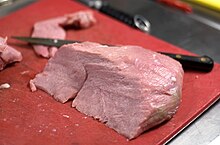veal

Veal is the meat of cattle ( calves ) that are a few weeks to months old . It is generally more tender and lighter than beef . Depending on the age and the type of rearing and feeding, it has a light red, pink or whitish color. The meat turns red when kept on pasture and with pure green fodder, while it is lighter when fattened. There are different levels of fattening: in the first level, the calves are housed in individual boxes in order to be able to observe them closely and to feed them. At this stage the calves can see each other. When they are six weeks old, they are kept in groups of at least three animals. It is common practice that animals have enough light so that they can develop well. "White" veal can be made with feed that is low in iron, as iron gives the meat a reddish color. Higher prices are obtained for the characteristic, lighter colored meat.
In Germany, calves are usually slaughtered at around 22 weeks of age. This corresponds to around 2% of their natural maximum life expectancy of 20 years. When they are slaughtered, the calves have a slaughter weight of around 150 kg. If a not yet fully grown cattle weighs more, there is also the term young cattle . So far, however, there has been no legal stipulation for this in the relevant trade classes for beef . But in June 2007 the European Union stipulated for the entire EU which meat could be called veal. According to this, the calves may not be more than eight months old; between eight and twelve months they are considered young cattle . The regulation came into force on July 1, 2008.
While in many European countries the fattening calves are mainly fattened with milk and dairy products and slaughtered when they are only a few months old, in some countries such as Denmark , Spain and the Netherlands there is a different rearing system in which the animals are mainly fed with grain and only after the tenth month to be slaughtered. These animals for slaughter must be marketed as young cattle.
Production and consumption
A total of around 800,000 tonnes of veal are produced in the EU each year. The most important producer countries are France (share of 30%), the Netherlands (26%), Italy (18%), Belgium (7%) and Germany (6%). The largest consumer countries are France and Italy.
In Germany, an estimated 9 kg of veal and beef per capita were eaten net (excluding tendons and bones) in 2016. In Austria, net consumption was 17.4 kg / person in 2015. The gross meat consumption here was 97.2 kg / person.
The parts of the veal that are suitable for roasting, namely those from the back and the leg ( upper shell , lower shell and nut ), are considered to be of particularly high quality . Bow, neck, thinning (belly), breast and knuckle are suitable for cooking and braising . The calf's head , tongue and ears are rarely used in the kitchen these days.
Veal is low in fat and should be cooked gently so that it does not dry out.
Raw veal chop with fillet
Market relief measures
Because in Switzerland, as a result of the main calving season in winter, the supply of domestic slaughtered calves exceeds demand in spring, veal is stored in spring to support calf prices. Based on Article 50 paragraph 1 of the Agriculture Act, the federal government pays meat processing companies around 3 million francs per year as a contribution towards storage costs and the loss in value as a result of freezing veal.
Web links
Individual evidence
- ↑ EUR-Lex - 32013R1308 - EN - EUR-Lex. Retrieved October 31, 2019 .
- ↑ Heinrich Boell Foundation: Fleischatlas 2018, p. 13 . ( boell.de ).
- ↑ Martin Schlatzer, Thomas Lindenthal: Analysis of agricultural animal husbandry in Austria - environmental and animal welfare aspects, p. 18. Accessed on October 31, 2019 .
- ↑ The veal shank, also known as the veal shank, is a part of the calf's leg that is located between the knee or elbow joint and the tarsal joints.
- ↑ Federal Office for Agriculture : Consultation on agricultural policy from 2022 (AP22 +). (PDF; 3.5 MB) Explanatory report. In: admin.ch . November 14, 2018, p. 62 (Market relief measures for meat and eggs) , accessed on January 1, 2020 .




